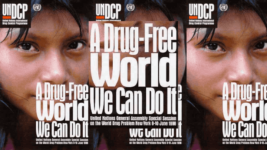United Nations Abandons Futile Objective of a Drug-Free World

The 55th meeting of the Third Committee at the 77th session of the UN General Assembly took place on 17 December.
And those gathered deliberated upon resolution L.13/Rev.1, which is titled, Addressing and Countering the World Drug Problem Through a Comprehensive, Integrated and Balanced Approach.
This international drug control resolution was significant as it broke new ground for the United Nations due to the fact that the General Assembly dropped its decades-long approach to the issue, which prioritised establishing a drug-free world.
The process of adopting the resolution was unprecedented also, as instead of reaching a consensus the drug policy document was put to the vote, with 116 states voting in favour, 9 voting against, and 45 states abstaining.
This month’s resolution used measured language to discuss the issue illegal drugs and offences, and, in an admission that the war on drugs isn’t working, the statement refrains from stipulating the previous aim of creating “a society free of drug abuse”.
Mexico tabled the resolution, and its ambassador explained that over the last two years, 284 million adults worldwide took drugs, with 11 million injecting them, while cocaine production reached new heights, trafficking in methamphetamine increased and opium production grew by 7 percent.
“The world drug problem is far from being resolved and it is increasing year upon year” she said, “Our organisation cannot ignore these appalling figures by indifferently repeating the same words year after year.”
The harms of prohibition
In mid-1998, the UN General Assembly held a special session on the world drug problem, under the banner of a drug-free world: we can do it.
Yet, the aim of eradicating illicit substances from existence had about as much likelihood of success as Nancy Reagan’s failed policy of just saying no to drugs.
But drug war rhetoric was front and centre in the 1990s. And it wasn’t until the Global Commission on Drug Policy released its first report in 2011 that significant questioning of the premise that underpins drug prohibition began at a high level.
Made up former heads of state and renowned intellectuals, the commission, in its first assessment, found that instead of reducing drug use, the war on drugs has actually increased use, availability and the harms associated with drugs, along with propagating mass incarceration.
The new UN drug resolution goes on to acknowledge the harms produced by the heavy-handed law enforcement approach taken to drug use over the last half century, including the systemic racism of law enforcement and criminal justice systems.
And the resolution further recognises the right of Indigenous peoples to harvest plants for medicinal purposes.
A global shift
Not all state parties were satisfied with the language of the newly adopted resolution. This included Russia and India, with these nations raising concerns about the shift away from the policy goal of a drug-free world.
The majority of ambassadors present, however, voted in favour of this move towards a public health approach to illegal drugs, rather than continuing on with the hazards of a zero-tolerance way of dealing with illicit substances.
Indeed, whilst the new resolution shirks at mentioning the term harm reduction, the language it uses points to the concept. And it’s hoped that this is the first step in a shift towards a more progressive approach to illegal drugs at the international level.







